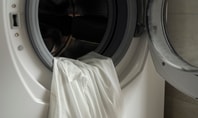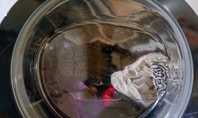Detergent allergy: symptoms and what you can do about it
Bought a new detergent and love its smell and how well it cleans your clothes? Excellent – or at least it would be if it weren’t for the itchy red skin a few days after your first wash. This may indicate a detergent allergy, i.e. you are sensitive to certain ingredients in your new detergent.
by CALIDA
July 3, 2024•6 min reading time

Recognising and treating symptoms of a detergent allergy
Table of Contents
Detergent rash? Typical symptoms of a contact allergy
The triggers: detergent ingredients as potential allergens
• Surfactants can also cause allergies
• Other triggers of supposed detergent allergies
Allergy tests provide information on allergens
What allergy sufferers should look out for when choosing detergents and fabric softeners
• Detergents for sensitive skin are not always the solution
• Wash your laundry correctly if you have a detergent allergy
• Remove detergent residue from the washing machine
Easily make your own environmentally friendly washing powder without allergens
Detergent rash? Typical symptoms of a contact allergy
After washing your clothes with a new detergent or fabric softener, the first reactions may occur around two to three days after wearing the fresh clothes. Your skin is usually the first to react, but the respiratory tract and mucous membranes can also be irritated. Typical symptoms of a contact allergy caused by ingredients in detergent are:
Itching
Pustules and blisters
Red rash
Dry, flaky skin
Swelling
Stinging eyes
Sore throat or coughing
Since a detergent allergy is a contact allergy, red eyes or respiratory problems can occur especially if you have also washed towels and bed linen with the new detergent. It is not always easy to find the exact trigger, as the allergy tends to first appear a few days after contact.
However, if sensitisation is particularly severe, the symptoms may also appear immediately after first contact with the fresh washing. Symptoms usually include severe itchy rashes, which intensify in areas where there is strong friction between the skin and the substance, for example on the elbows, backs of the knees and under the armpits.
The triggers: detergent ingredients as potential allergens
If you take a look at the ingredients list on a conventional detergent, you’ll quickly realise that identifying the one allergen responsible for your laundry detergent allergy won’t be easy.
The big problem is that some fragrances that are often the trigger of a contact allergy, are usually only declared as ‘perfume’. In addition to perfume, other chemical substances in detergent can also trigger an allergy. Usually, these are enzymes that help to deep-clean your laundry. Preservatives, which are mainly included in liquid detergents, can also trigger allergies.
After initial skin contact with these ingredients, your immune system reacts with an overreaction. Your body releases inflammatory messengers that are supposed to fight the supposedly harmful substance – this causes eczema, pustules, etc. The causes of this sensitisation are usually genetic, but they can also be related to lifestyle factors, stress or an already weakened immune system.
Surfactants can also cause allergies
The surfactants in detergent are often also cited as potential allergens, but this is not the case – not directly, anyway. The cleaning surfactants do not trigger an allergy, but they can encourage it by irritating the skin. The protein-dissolving properties of surfactants also make the skin susceptible to certain proteins. These proteins can, in turn, trigger an allergic reaction.
Other triggers of supposed detergent allergies
Generally, allergies to detergents and fabric softeners occur when you use a new product. The body is then sensitised to an ingredient and develops an allergy. However, if a supposed allergy to detergents occurs without changing your laundry products, something else is likely behind it.
If you wake up in the morning and notice red pustules on your body, it could be indicative of dust mites, for example. A runny nose and reddened inner elbows are common in the spring, when the pollen season kicks off in earnest and causes classic hay fever. Have you been visiting friends with pets lately? Animal hair allergies can also develop suddenly and are similar to the symptoms of a detergent allergy. If you are unsure, allergy tests can help to identify the actual allergen.
Allergy tests provide information on allergens
To find the specific trigger of your allergy, you can undergo allergy testing. Many dermatologists, ENT doctors and paediatricians are also trained in the field of allergology.
To find the allergen, you should provide a list of suspected culprits and bring your detergents and cleaning products with you, if necessary. Many typical allergens are already known to doctors; they can point out the irritating ingredients.
During an allergy test, your skin is exposed to several possible allergens. After about two days, you will be able to see which allergens your skin is reacting to and you’ll be able to replace the detergent and cleaning products containing the substance in question.
What allergy sufferers should look out for when choosing detergents and fabric softeners
Depending on the severity of your detergent allergy, several aspects of how you wash your laundry should be changed. In general, the more natural, the better. For this reason, experts also advise against using fabric softener.
Fabric softeners and laundry perfumes contain significantly more potential allergens in the form of softening agents and unnatural fragrances and preservatives. To soften your clothes naturally, simply add three to five tablespoons of white vinegar to your clothes in the washing machine.
Detergents for sensitive skin are not always the solution
When looking to avoid allergens, we tend to turn to detergents made for sensitive skin. However, this term is not protected and therefore provides no information about the suitability of the product. Instead of using sensitive detergents, you should use cleaning agents that are also suitable for baby clothes. It is also better to opt for washing powder instead of liquid detergent. The latter contains more preservatives and is therefore less suitable for allergy sufferers.
In addition, labels such as the logo of the German Allergy and Asthma Association (DAAB) and the seal of the European Centre for Allergy Research Foundation (ECARF) provide information on the suitability of products. Detergents bearing these logos are usually fragrance and preservative-free or contain only natural fragrances and preservatives and therefore exclude most typical allergens.
Wash your laundry correctly if you have a detergent allergy
Detergent residue on clothing often causes particularly strong allergic reactions. To prevent this from happening, you should always wash your clothes thoroughly and for long enough. In short or sports wash cycles, your clothes are less likely to be rinsed through, leaving washing powder residue stuck in the fabric. Also, make sure never to use more than the recommended amount of detergent for the level of soiling and water hardness in your area.
To ensure that all detergent residues have been removed, you can run an extra rinse cycle without detergent. You should also never overload your washing machine to allow water and detergent to drain freely; for normal cotton clothing, a maximum load of 60% to 80% is ideal. Delicate garments usually require even more space in the washing machine.
Remove detergent residue from the washing machine
If you’ve been able to work out what triggers your detergent allergy and replace the detergent, you should clean your washing machine before the next wash cycle. Run your unloaded washing machine on a boil wash cycle to sanitise it and remove any remaining allergens from the machine.
Easily make your own environmentally friendly washing powder without allergens
People with very sensitive skin react to several ingredients and therefore to most laundry detergents sold on the market. To ensure that your laundry is still hygienically clean, you can easily make your own detergent suitable for sensitive skin using just three ingredients. This method is not only suitable for allergy sufferers, but also protects our environment. Allergen-free detergent can be made using:
Sodium carbonate (40%)
Sodium bicarbonate (40%)
EDTA-free curd soap (20%)
Here’s how: mix the three ingredients together in the specified quantities – i.e. two parts each of sodium carbonate and sodium bicarbonate and one part of the organic curd soap. You should grate the curd soap as finely as possible with a kitchen grater.
While bicarbonate of soda has an antibacterial effect, sodium carbonate removes stubborn dirt. Curd soap is a powerful degreaser and completes the detergent. Depending on the degree of soiling, one to three tablespoons of home-made laundry powder is enough to clean your laundry.
If you want to wash white clothes, you can also add a dash of citric acid to the washing machine. White vinegar will make your laundry particularly soft. If you don’t want to miss out on the smell of freshly washed laundry, you can also add a few drops of essential oil. If you have a detergent allergy, however, you should make sure that your skin can tolerate this first and use only natural organic oils.
Discover more interesting blog posts:


